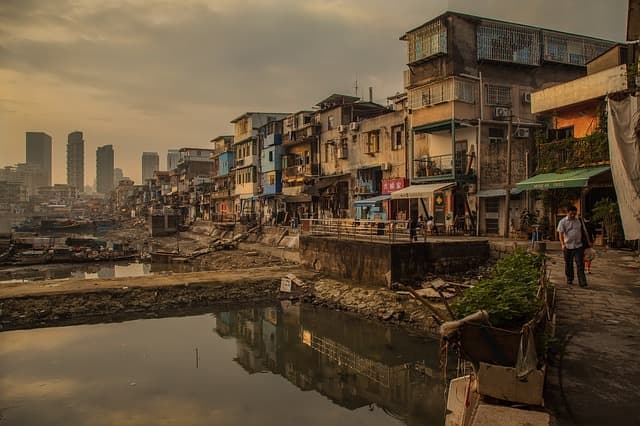A 2023 meta-study by the World Bank Infrastructure Chief Economist’s Office titled “The Impact of Infrastructure on Development Outcomes: A Meta-Analysis,” confirms what we have known all along: properly-managed infrastructure development cannot be separated from poverty alleviation. And as most policymakers agree, a reduction of poverty is often a necessary precondition towards sustainably meeting most other national goals, whether they are economic or socio-cultural. Here, we’ll look at several key points that explore how infrastructure development reduces poverty in communities and helps them become freer and more engaged in nation-building:
Better Infrastructure Reduces Economic Burdens on Communities
Impoverished communities have the same needs as their more prosperous counterparts. However, the key difference is that, without infrastructure, residents of poorer communities end up spending more on everything.
Without proper roads, schools, and hospitals, they have to spend more time and money to access goods and services that other better-developed communities take for granted. As a result, individuals in poorer communities have problems saving money, developing valuable skills, getting financing to start businesses, or accessing basic healthcare.
Better infrastructure programs reduce serious burdens on poorer communities, making them a key aspect of any serious poverty alleviation effort. Improved infrastructure reduces travel costs and time and facilitates access to job opportunities, education, healthcare, and markets. This accessibility helps individuals escape the cycle of poverty by saving them the resources needed to become upwardly mobile.
Infrastructure Lays the Groundwork for Investment
Better infrastructure also encourages investment in communities by enabling an environment where businesses can operate efficiently. Upgraded power grids, water supply systems, and communication networks also attract private investments, both domestic and foreign, driving economic growth and job creation. These stimulate local industries, create employment opportunities, and enhance income levels, ultimately reducing poverty in the community.
In Asia, this theory was put directly to the test with the development of various special economic zones with advanced infrastructure distinct from that of their home countries. In the Philippines, for example, Aboitiz InfraCapital’s countryside economic estates have proven to be a magnet for a host of international investments that gave locals better job opportunities and living conditions that were once only available in larger cities or overseas. These patterns have mostly been repeated wherever serious infrastructure projects have been undertaken.
Improves Local Entrepreneurship and Market Access
While attracting outside investment is important, stoking local entrepreneurship is just as critical as it provides avenues to escape poverty while also developing the agency communities need to shape their economic destinies. Better roads and more robust digital communications networks provide communities with the preconditions to access markets, develop professional networks, and learn valuable ideas. And as previously mentioned, proper infrastructure development helps communities save time and money that could be used for other value-creating activities.
Increases Resilience to Calamities
Poor communities are particularly vulnerable to disasters, not only because they rarely have the necessary protective infrastructure, but also because they have fewer resources with which to rebuild should the worst happen. Building robust housing, flood control systems, early warning systems, and disaster response mechanisms enhance the resilience of communities, not only reducing the loss of lives, assets, and livelihoods during emergencies but also helping them cope better in the difficult aftermath, preventing a deeper slide into poverty.
Catalyzes Rural Development
Investments in irrigation systems, rural electrification, farm-to-market roads, and affordable agricultural processing facilities are necessary for driving rural development and poverty reduction. These infrastructure systems help improve agricultural yields and also increase access to markets and services, reducing the dependence of rural communities on compradors to facilitate economic activity. The net effect of these improvements is to take the brakes off of rural economies, allowing them to grow and keep more of their produced value.
Strengthens Social Safeguards
Critiques of infrastructure development often center around the cost to build and maintain key infrastructure projects, with many critics often pointing out that the funds used for roads, hospitals, and other such assets could be used for more immediate concerns. While there is occasionally some merit to these objections, properly implemented infrastructure almost always results in a strengthening rather than an erosion of social safeguards.
By and large, infrastructure development enriches communities, empowering them to take care of members who cannot work. For instance, financially secure families do not have to slide into poverty to take care of a sick child or an elderly parent. National and local governments may also get more funding from resulting economic boosts, enabling them to provide more social benefits.
What’s more, a 2022 study published in the International Journal of Environmental Research and Public Health shows that the availability of social support creates the conditions needed for individuals to engage in creative pursuits. In other words, the stronger social support networks that are, in part, enabled by better infrastructure can be seen as necessary for building and maintaining culture.
Infrastructure Assets: The Building Blocks of Prosperity
Better infrastructure creates the long-term conditions needed to eradicate poverty, create social progress, and improve living standards. While there may be some rhetoric critical of the role of infrastructure in lifting disadvantaged groups out of poverty, virtually all the evidence and real-world experience point to infrastructure development as a precondition not only for poverty eradication but also for freer and more inclusive societies.